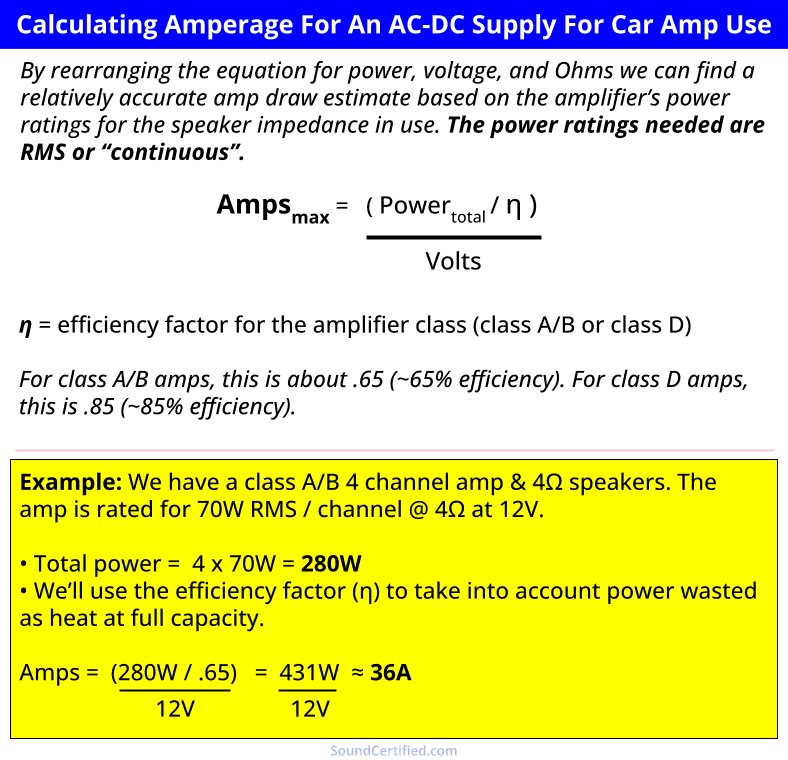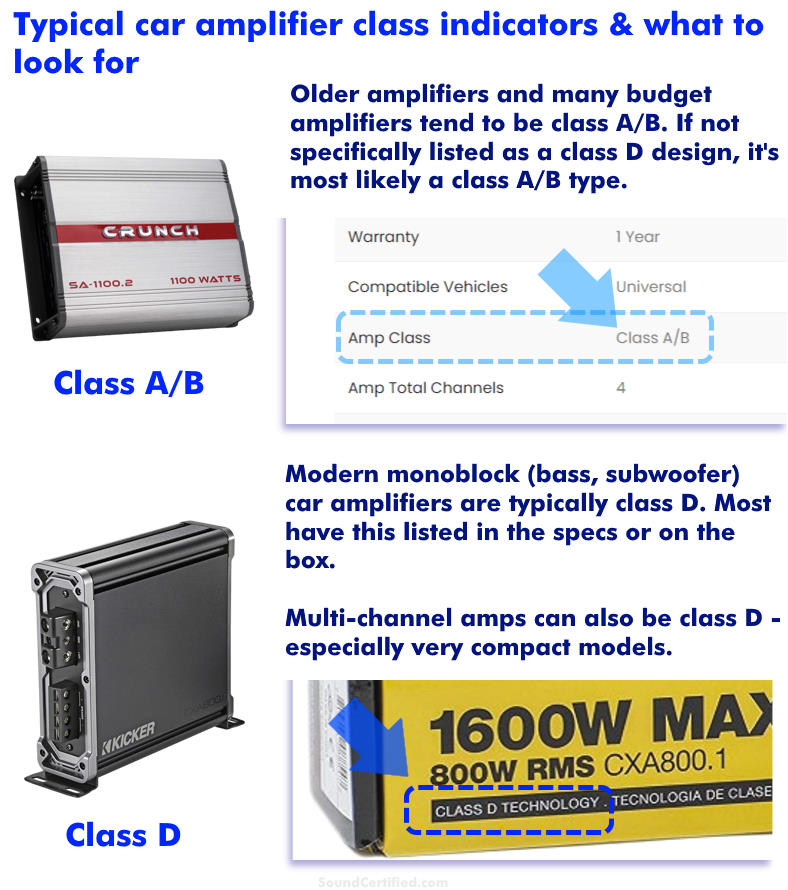Want to use a car stereo in your home? My handy calculator will help you find out what amperage rating you’ll need from an AC-DC power supply with your amplifier – in addition to lots of great info to help.
Note: Javascript must be enabled in your browser to see or use the tool.
Contents
CAR AMP DC POWER SUPPLY AMPERAGE CALCULATOR
HOW TO USE THE CALCULATOR:
- Enter the amplifier’s power rating.
- Enter the total power rating for all channels you’re using & the speaker Ohms in use. For example, a 2-channel amp with 100W RMS @ 2Ω would mean a total of 200W. For a 4 channel amp with 50W x 4 @ 4Ω, we could use 4x50W = 200W total.
- NOTE: Use the RMS or continuous power rating for the amplifier at the speaker impedance you’ll be using. (Do not use “peak” or “max.” power ratings – this will give exceptionally high numbers that aren’t correct.)
- Choose the amplifier class you’re using. For example, most budget 2 or 4-channel amps are often class A/B, and many mono amps today are class D. This is usually specified by the manufacturer. If not, it’s most likely class A/B.
- (Optional) Choose a supply voltage. This is optional and will affect the current rating as well. If you don’t know this or the manufacturer hasn’t specified it, leave it as 12V default.
- Touch the button to display results.
The calculator will output:
- The estimated ampere rating, in amps (A), for a DC power supply based on the maximum draw at full power.
- A 1/2 amperage rating for moderate use as you typically don’t need full power from your car amp for home use.
How does the car amp power supply calculator work?
It’s possible to roughly estimate the size of the AC-DC power supply you’ll need to use for a car amp based on one of two things;
- The included fuse size (ex.: 40A, 60A, etc.)
- Manufacturer maximum current draw specification, in Amps.
However, if you don’t know those two things or prefer a bit more accuracy, you can also use the total power rating along with a few more factors:
- Efficiency: Car amplifiers aren’t 100% efficient. This means some additional power is wasted as heat, especially in class A/B amplifiers. Class D amplifiers produce less heat because they’re more efficient.
- Supply voltage: Manufacturer power ratings sometimes clarify the supply voltage for their power ratings, with 12V, 13.8V, and even 14.4V being typical. 12V is one of the most common (and also assumed to be the case if it’s not specified).
- Speaker impedance: Car amplifiers have power ratings for a given speaker Ohms used, which also affects the current they can supply and therefore the current they’ll draw.
My calculator uses these factors to help give you a slightly better estimate based on these factors that affect current draw as well as your particular use case.
For example, If you’re only using two channels out of 4 on a 4-channel amp, you won’t be using the same amount of power as if all 4 were in use. Additionally, using different impedance speakers affects the power use as well.
Do you really need a huge power supply?
The truth is that when using car stereo system component at home you typically won’t need high power for casual or moderate music listening. That’s because a lot more power, in Watts, is needed due to the terrible acoustics, road noise, and other factors that must be overcome with more power in a vehicle.
Indoor listening is less power-hungry since the acoustics (in a mostly closed room, for example) tend to help retain sound which you can hear with lower power levels being ok.
Here are some basic guidelines for getting an AC-DC power supply for home car stereo use:
- If you want to power the amplifier close to or at full power, you’ll want one rated for at least the maximum current draw estimate. However, DC power supplies can be finicky and may “trip” due to hitting an overcurrent limit before their advertised limit is reached.
- I typically recommend getting a supply that’s at least 15 to 20% higher than the estimated max. current you think you’ll need.
- For casual listening, a good rule of thumb is to get one around 1/2 of the estimated max. current draw.
- When powering car subwoofers for bass you’ll need to provide adequate current as they’re often inefficient and they’re power-hungry when more volume is needed.
As a general rule, most amplifiers can power up and play sound using even only a 5A (5 amp) DC supply. However, for “real” listening you’ll want one that’s at least 15A or higher.
AC-DC power supply voltage notes
When it comes to the voltage you’ll need, 12V is usually fine and is one of the most common you’ll find when shopping. Most car amplifiers can work at a voltage as high as close to 15V, so there’s no strict requirement as long as it falls into an acceptable range of around 12V to below 15V.
12V DC switch-mode power supplies (SMPS) are some of the most affordable, too.
Many have an adjustable voltage output control that allows a slight adjustment to be made (usually within say 2-4 volts or so). As a rule, try to avoid letting your DC supply reach 11V or below as some car amps or head units can’t function at a voltage that low and may shut off.
13.8V supplies are fine as well and are often used for CB radio and related equipment use.
Identifying car amplifier classes
The “class” of an audio amplifier refers to the design technology used to create the power used to produce amplified signals. Additionally, the way the audio signal input is used is different between various classes.
While in the world of home stereo and vacuum tube amplifiers, other classes can be found, almost all modern car amplifiers tend to be class A/B or class D. Class A/B is a compromise between class A designs (very high fidelity but very poor efficiency) and class B (higher efficiency but lower sound quality).
Class D designs use a more efficient topology which reduces energy wasted as heat while being able to deliver more power in a compact size. It has become more and more popular and is being sold in more and more applications because of the benefits.
How do I know what class of amplifier I have?
- Class A/B: Older amplifiers and many budget amps are class A/B. If the manufacturer doesn’t specifically list an amp as A/B in the specifications or product description, it’s most likely a class A/B type.
- Class D: Many monoblock subwoofer amps and compact multi-channel full range amps now use this design technology. Unlike A/B types, these are normally listed as being “D” in the specifications or sales listing.



